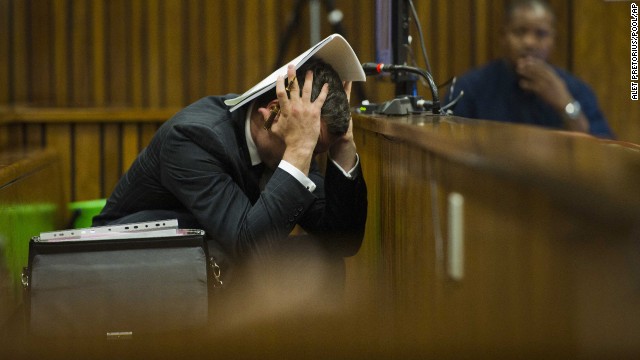Pretoria, South Africa (CNN) — The top police commander on the scene the night Oscar Pistorius killed Reeva Steenkamp will testify against the Olympic athlete at his murder trial Friday.
Former police colonel G.S. van Rensburg first took the stand Thursday, and said paramedics were already there when he arrived at Pistorius’ address about 3:55 a.m., but Steenkamp was dead.
As he testified, the prosecution showed more than 100 police photographs taken at Pistorius’ house after the killing, including the sprinter’s 9mm handgun, still cocked and ready to fire, on a bloody towel or bathmat on a blood-spattered floor.
Both prosecution and defense accidentally displayed photos of Steenkamp’s dead body and mortal wounds Thursday, prompting the man who killed her to be violently sick.
Pistorius threw up after both defense and prosecution lawyers scrolled on monitors through evidence photos to find the ones they wanted to discuss — flashing past the gruesome images as they did so.
 Photos: Oscar Pistorius murder trial
Photos: Oscar Pistorius murder trialThere’s a monitor directly in front of Pistorius as he sits in the dock, on trial for murder.
The South African Olympic sprinter admits that he killed Steenkamp, his girlfriend of about four months, on Valentine’s Day last year, but says it was a terrible accident, not premeditated murder.
He shot her through a locked bathroom door in his house, saying he thought she was an intruder, then broke the door down with a cricket bat to get to her when he realized his mistake. She was 29.
Pistorius, 27, pleaded not guilty to murder and three other weapons charges.
Air rifle, bat kept by bedroom door
The prosecution Thursday talked van Rensburg through police photographs of the athlete’s house taken on that night. They showed some small spots of blood on chairs in the downstairs sitting room, and a trail of blood that led upstairs.
Pistorius appeared calm and took notes as the photographs revealed the gun, still cocked, on a gray towel or bathmat in the bathroom. A black cell phone lies on the floor next to it and blood spatter can be seen on the floor.
Another image showed a bloodstained towel in the bathroom, as well as a cricket bat and bullet cartridge on the bathroom floor, next to large bloodstains.
The photos also indicated that Pistorius kept an air rifle and baseball bat by the bedroom door.
Other police photos included one of a magazine with bullets and pouch taken from the right-hand bedside drawer, and a close-up of the magazine with a hollow-tip bullet, the kind that killed Steenkamp.
Some of the photographs appeared consistent with Pistorius’ version of events that night.
One showed a fan by the right hand side of the bed, which may gel with Pistorius’ account that he went out to get the fan from the balcony before hearing noises he thought were made by an intruder.
Stumps or prosthetics?
Earlier Thursday, the athlete looked tired as he watched his defense lawyer painstakingly cross-examine a police forensics expert, whose testimony a day earlier threatened to discredit him.
Defense lawyer Barry Roux picked at forensic expert J.G. Vermeulen’s testimony with fastidiously detailed questions about the validity of evidence offered by the dents, gashes and scratches on the bathroom door.
On Wednesday, Vermeulen, a police colonel, provided some of the trial’s most dramatic testimony by swinging Pistorius’ own bat at that very door from Pistorius’ home, assembled in court for the judge in the Pretoria courtroom to see.
The prosecution and defense disagree over whether the runner was wearing his prosthetic legs at the time he broke into the toilet.
The officer concluded that Pistorius was on the stumps of his legs when he battered the door.
Pistorius’ legs are amputated below the knees, and he wears prostheses. He is widely known for the blade-shaped ones he dons for track competitions, which have earned him the nickname “Blade Runner.”
As Roux grilled Vermeulen, images quickly flipped by, and a photo of Steenkamp’s body lying on its back and other bloody scenes flashed on the monitors around the court. One is directly in front of the accused.
Pistorius’ face sank into his hands.
That torment repeated itself later in the day. That’s when Pistorius could take it no longer.
After he vomited, the prosecution had graphic photos removed from the slide presentation.
Gun at his bedside
The case against Pistorius is largely circumstantial, prosecutor Gerrie Nel said in his opening statement last week. Pistorius and Steenkamp were the only people in his house when he killed her.
Nel has been building a picture of what happened through the testimony of experts; neighbors who heard screaming and bangs that night; current and former friends of Pistorius; and a security guard who sped to the scene because of reports of gunshots.
Many prosecution witnesses’ accounts are consistent with Pistorius’ version of events — that he got up in the night, went out to his balcony to get a fan, came back inside and heard noises in the bathroom that he thought came from an intruder.
He said he took the gun and fired while calling for Steenkamp to call police. When she didn’t answer, he realized it could have been her in the bathroom, he said.
Samantha Taylor, a former girlfriend of Pistorius, testified last week that he reacted similarly once when she was sleeping at his house.
She said he once heard something hit a bathroom window and woke her up to ask if she’d heard it, too, before taking his gun and going to investigate. Taylor said Pistorius woke her up other times when he thought he’d heard a noise.
Who was screaming?
Neighbors said they heard a woman screaming before the shots were fired. But the defense is proposing that what neighbors thought was Steenkamp screaming in fear for her life was in fact Pistorius when he realized what he had done.
Pistorius and at least two neighbors made phone calls to security after the shooting, allowing the defense to use phone records to establish a timeline of events.
Judge Thokozile Masipa will decide the verdict. South Africa does not have jury trials.
In South Africa, premeditated murder carries a mandatory life sentence with a minimum of 25 years. Pistorius also could get five years for each gun indictment and 15 years for a firearms charge he also faces.
If he isn’t convicted of premeditated murder, the sprinter could face a lesser charge of culpable homicide, a crime based on negligence. The sentence for culpable homicide is at the judge’s discretion. The trial is expected to take at least another week.
 Q FM Africa's Modern Radio
Q FM Africa's Modern Radio